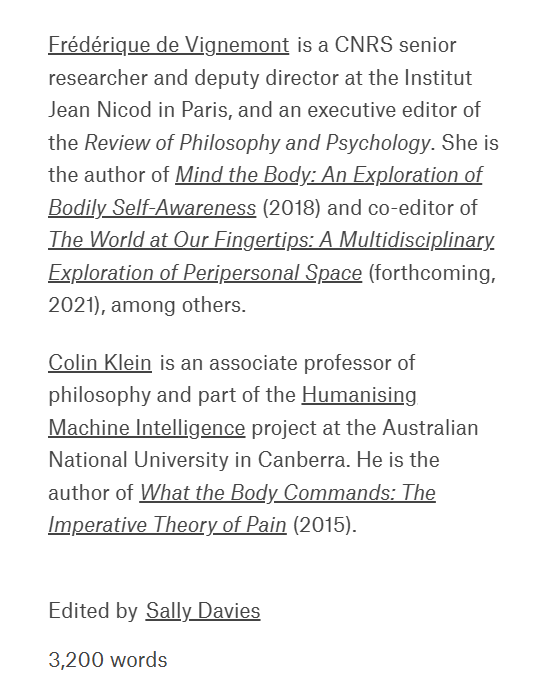Welcome to DU!
The truly grassroots left-of-center political community where regular people, not algorithms, drive the discussions and set the standards.
Join the community:
Create a free account
Support DU (and get rid of ads!):
Become a Star Member
Latest Breaking News
Editorials & Other Articles
General Discussion
The DU Lounge
All Forums
Issue Forums
Culture Forums
Alliance Forums
Region Forums
Support Forums
Help & Search
The DU Lounge
Related: Culture Forums, Support ForumsHow close is too close?

The neuroscience of peripersonal space explores how you create, defend or relax the buffer zone between you and the world
https://aeon.co/essays/where-is-the-dividing-line-between-you-and-the-world

Władysławowo beach, Poland, August 2020. Photo by Kacper Kowalski/Panos Pictures

Heini Hediger, a noted 20th-century Swiss biologist and zoo director, knew that animals ran away when they felt unsafe. But when he set about designing and building zoos himself, he realised he needed a more precise understanding of how animals behaved when put in proximity to one another. Hediger decided to investigate the flight response systematically, something that no one had done before. Hediger found that the space around an animal could be partitioned into zones, nested within one another, and measurable down to a matter of centimetres. The outermost circle is what’s known as flight distance: if a lion is far enough away, a zebra will continue to graze warily, but any closer than that, the zebra will try to escape. Closer still is the defence distance: pass that line and the zebra attacks rather than fleeing. Finally, there’s the critical distance: if the predator is too close, there’s nothing to do but freeze, play dead and hope for the best.
While different species of wild animals have different limits, Hediger discovered that they’re remarkably consistent within a species. He also offered a new definition of a tame animal, as one that no longer treats humans as a significant threat, and so reduces its flight distance for humans to zero. In other words, a tame animal was one to which you could get close enough to touch. Like all animals, humans also protect themselves from potential threats by keeping them at a distance. Those of us beginning to see friends again after months of pandemic-induced social distancing can feel this at a visceral level, as we balance the desire for contact against a sense of risk. Once we evaluate something as a potential threat – even if that assessment is informed by public policy or expert prescription – there’s a powerful urge to maintain a buffer of space.
This buffer is a byproduct of our evolutionary history, which has equipped our brains with a way to acknowledge and track the importance of our immediate surroundings. That mechanism is known as peripersonal space, the region in and around a person’s body (peri comes from the Ancient Greek meaning ‘about’, ‘around’, ‘enclosing’ or ‘near’). Peripersonal space exists in various forms across the animal kingdom, from fish and fruit flies to wild horses and chimpanzees. The neuroscience behind it sheds fascinating light on how humans and other animals conceive of themselves and their boundaries. Where is the dividing line between you and the world? You might think that this is a clean-cut question with a simple answer – your skin is the boundary, with the self on one side and the rest of the world on the other. But peripersonal space shows that the division is messy and malleable, and the boundary is blurrier than you might think.

The peripersonal zone is a nexus where space, time and survival are tightly bound together. Maintaining a buffer of peripersonal space is important because it gives an animal time to react to a threat before it’s too late. A predator isn’t merely present at an objective distance, but feels either too close for comfort or far enough away. Peripersonal space, then, is space that has significance, and this significance depends on what matters to you, and on your state of mind. The story of peripersonal space is thus a story about the entanglement of space and meaning. It’s also the story of why ‘needing space’ during stressful times is more than just a metaphor, or how we can successfully navigate the crowded metro during rush hour, or how we can hammer a nail without hitting our thumb. And it is, deep down, a story of all the beautiful neural engineering that allows for self-protection in an ever-changing world.
snip
2 replies
 = new reply since forum marked as read
Highlight:
NoneDon't highlight anything
5 newestHighlight 5 most recent replies
= new reply since forum marked as read
Highlight:
NoneDon't highlight anything
5 newestHighlight 5 most recent replies
How close is too close? (Original Post)
Celerity
Aug 20
OP
GreenWave
(11,752 posts)1. Billions of neutrinos pass right through us all the time.
We are covered with billions of microbes and our viromes have trillions of viruses on each of us.
I, or dare I say "we", have reached an understanding.
CrispyQ
(40,300 posts)2. Is this a trend on American beaches too, putting a wall up around your spot for the day?
I can't tell how tall they are. As long as they aren't too tall, table height, max, like tents we made in the house when we were kids. OTOH, it's kind of weird, like setting up a mini-neighborhood, which is what you're trying to get away from, right? IDK.